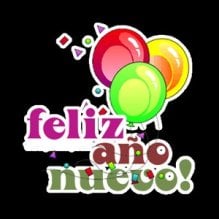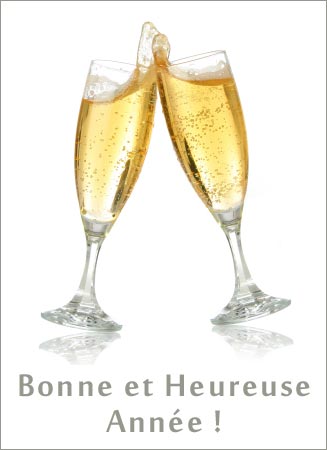New Year Around the World
The New Year has not always begun on January 1, and it doesn't begin on that date everywhere today. It begins on that date only for cultures that use a 365-day solar calendar.
January the 1st became the beginning of the New Year in 46 B.C., when Julius Caesar developed a calendar that would more accurately reflect the seasons than previous calendars had. The Romans named the first month of the year after Janus, the god of beginnings and the guardian of doors and entrances. He was always depicted with two faces, one on the front of his head and one on the back. This way, he could look backward and forward at the same time. At midnight on December 31st, the Romans imagined Janus looking back at the old year and forward to the new.

New Year Around the World
I have been lucky to spend New Year in several countries. What I have learnt is that it doesn’t matter where you are, people like to celebrate. Toasting, dancing and fireworks are a common denominator with most western cultures while traditions and customs are local. I cannot decide which country celebrates the best New Year; all I can say is that each country is different and at the end, the joy of welcoming a New Year has nothing to do with the place where you celebrate or how you celebrate it. The real joy of welcoming the New Year is sharing it with people you love and appreciate.


New Year in Peru and some family traditions
My first New Year memories go back to Peru. The first images that come to my mind are people dancing, fireworks in the streets, and homemade man-sized dolls burnt in the streets. New Year in Lima is a big festivity; even the poorest manage to enjoy big parties and celebrations. The only difference is the quality of the drinks and food. While the poorest celebrate with Cider, beer, and chicken; the richest celebrate with Champagne, Whiskey and turkey.
Fireworks were always a must during New Year, not big firework displays but small fireworks that the children are allowed to burn in the streets. We also had the tradition of making a man-sized doll which we stuffed with all sort of old stuff. The doll represented the old year and it was burnt at midnight as a way of burning and forgetting all the bad things that happened during the year.
Some of my family traditions were maybe a bit weird but I really enjoyed them and try to keep them wherever I go. For a start, we had to wear yellow underwear on the night of the 31st to bring good luck. I never knew the relation between good luck and deep yellow pants, but I enjoyed wearing mine, it was the only time that as a child I was allowed to wear such a daring colour of panties. We also had to sweep the house just before midnight to throw away all the bad things from the year that was ending and pass three times under the table for good luck at midnight.
Some of the traditions like eating a bowl of lentils for abundance the next year we have kept over the years, but other traditions we have forgotten because they were a bit hazardous, like my granny’s tradition to run around the block with her suitcase at midnight. This was to bring her luck for travelling. She did it every year, and every year she travelled somewhere exotic. She followed this custom for years until the year, when after running around the block she came in the house and slipped on champagne sprayed everywhere around the house by an uncle who had decided that spraying champagne at midnight would bring good luck. That year my grandma started the New Year with a broken arm, but still, she went to Brazil in February for the Carnival. However, we all forgot the custom of running with a suitcase in case the uncle came back with the champagne.
Big partys in Lima-Peru
The 12 grapes
The tradition of the 12 grapes goes back to 1909 when the Alicante Vineyards thought about it as a way to get rid of a surplus in that year’s production. However, the tradition stayed and the 12 grapes are now inseparable from the New Year festivities.
New Year in Spain
New Year in Spain, known as Nochevieja or Fin de Año, is a big event when the Spaniards take on the streets to celebrate. The most traditional place to celebrate in Madrid is La Puerta del Sol, a big square where people gather to wait for the New Year. For those who cannot get to the Puerta del Sol, most TV channels transmit live the chiming of the bells at midnight. Here it is a tradition to eat one grape with each bang of the bell. With each grape you must make a wish for the New Year. As easy as it sounds, the task is rather difficult and only if you manage to eat your 12 grapes one at each bang of the bell do your wishes come true for the coming year. After the 12th bang of the bells people hug and wish each other a happy New Year and toast with Cava.
In Spain, it also brings good luck to wear red underwear. On the Costa del Sol most bars and Disco's entrance fee come with a free drink and red knickers for girls and boys. Whether it brings good luck or not it gives some sexy sights of girls putting on their knickers at midnight in the bars. I did it in 2000 and I had incredible good luck all 2001 !
Puerta de Sol Madrid 2012 to 2013 : hear the bells at midnight
Hogmanay
New Year in Scotland
New Year in Scotland is known as Hogmanay and the celebrations concentrate in Edinburgh starting a few days before the 31st with The Torchlight Procession opening Edinburgh's Hogmanay festivities every year on 29th December. With torches flaming, several thousand people (around 15,000 in 2008) create a river of fire down from the Royal Mile to Calton Hill as they drag a Viking warship. The procession starts at around 6.30pm, even when outdoor temperatures are under zero. Once in Calton Hill the Viking ship is set on fire and there is also a firework display.
But if celebrations are wild in the Scottish big cities, small towns are not felt behind and the villagers gather around the Town’s clock to wait for midnight and start the kissing. Yes, in Scotland it is kissing that brings good luck! Happy New Year...
As the clocks strike midnight on 31st December 2008, fireworks explode above Edinburgh Castle and crowds join hands and sing in Auld Lang Syne to start off 2009

New Year in France
In France the night of the 31st is called Le réveillon de la Saint-Sylvestre ou le réveillon du Jour de l'an and it is usually celebrated with gatherings, copious dinners and heated dances. In France, one cannot separate New Year festivities from Champagne, foie gras and sea food.
In France people wait until the 1st of January to start sending New Year wishes cards. Christmas cards are not a big thing here; the card tradition concentrates around New Year instead. The official festivities end on the 6th of January with the Epiphany and a family gathering to eat the galette de Rois.
However, even a few days or weeks after the 1st of January people continue wishing each other a Happy New Year so do not be surprised if someone invites you for a drink and wishes you a happy New Year in February!
Réveillon - Paris - 2007/2008

New Year's Resolutions
- New Year's Resolutions
New Year's Eve has always been a time for looking back to the past, and more importantly, a time to look forward to the coming year. The end of a year pushes us to reflect on what we have achieved during the...
© 2009 Wendy Iturrizaga









